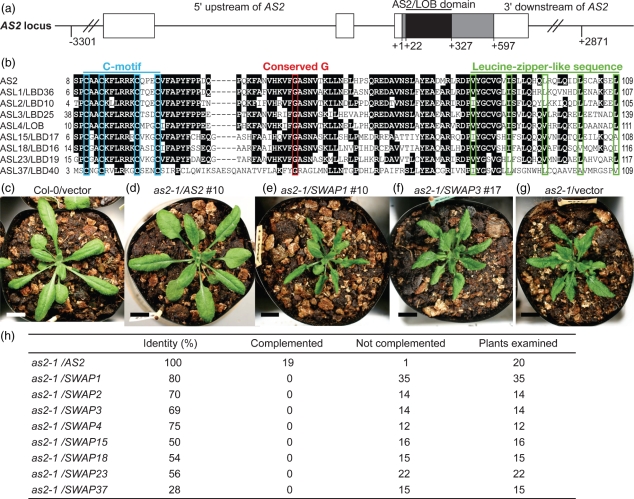Figure 5.
Replacement of the AS2/LOB domain of AS2 with that of various ASL/LBD proteins. (a) Schematic representation of the genomic fragment that includes the AS2 locus. Open and filled (gray and black) boxes represent untranslated and translated regions of the AS2 gene, respectively. The region corresponding to the AS2/LOB domain is indicated by a black box. Numbers below the line and boxes indicate the nucleotide positions of the translated region (from +1 to +597 nt), the region corresponding to the AS2/LOB domain (from +22 to +327 nt) and, positions upstream (−3301 nt) and downstream (+2871 nt) of translated regions of the AS2 gene, which were used for the domain-swapping experiments. (b) Comparison of the amino acid sequences of AS2/LOB domains. The sequence from residue 8 to residue 109 of AS2 is aligned with sequences from corresponding regions of the indicated ASL/LBD proteins. Amino acid residues conserved in more than five proteins are indicated by white characters on a black background. The consensus sequence of the C-motif, the conserved glycine residue and the hydrophobic residues in the leucine-zipper-like sequence are indicated by blue, red and green boxes, respectively. (c–g) Gross morphology of various as2-1/SWAP transgenic plants. The name and the line number of each transgenic plant are indicated above the respective panel. (c) A 38-day-old wild-type plant into which the empty vector had been introduced; (d) 30-day-old and (e) and (f) 33-day-old transgenic plants; (g) a 41-day-old as2-1 plant into which the empty vector had been introduced. (h) Classification of the as2-1/SWAP transgenic plants. The extent of the identity between the deduced amino acid sequence of the AS2/LOB domain of the indicated protein, and that of AS2, is shown as a percentage. Scale bars: 10 mm.

